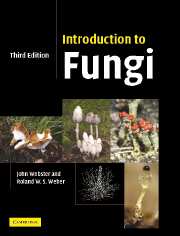Book contents
- Frontmatter
- Contents
- Preface to the first edition
- Preface to the second edition
- Preface to the third edition
- Acknowledgements
- 1 Introduction
- 2 Protozoa: Myxomycota (slime moulds)
- 3 Protozoa: Plasmodiophoromycota
- 4 Straminipila: minor fungal phyla
- 5 Straminipila: Oomycota
- 6 Chytridiomycota
- 7 Zygomycota
- 8 Ascomycota (ascomycetes)
- 9 Archiascomycetes
- 10 Hemiascomycetes
- 11 Plectomycetes
- 12 Hymenoascomycetes: Pyrenomycetes
- 13 Hymenoascomycetes: Erysiphales
- 14 Hymenoascomycetes: Pezizales (operculate discomycetes)
- 15 Hymenoascomycetes: Helotiales (inoperculate discomycetes)
- 16 Lichenized fungi (chiefly Hymenoascomycetes: Lecanorales)
- 17 Loculoascomycetes
- 18 Basidiomycota
- 19 Homobasidiomycetes
- 20 Homobasidiomycetes: gasteromycetes
- 21 Heterobasidiomycetes
- 22 Urediniomycetes: Uredinales (rust fungi)
- 23 Ustilaginomycetes: smut fungi and their allies
- 24 Basidiomycete yeasts
- 25 Anamorphic fungi (nematophagous and aquatic forms)
- References
- Index
- Plate section
Preface to the third edition
- Frontmatter
- Contents
- Preface to the first edition
- Preface to the second edition
- Preface to the third edition
- Acknowledgements
- 1 Introduction
- 2 Protozoa: Myxomycota (slime moulds)
- 3 Protozoa: Plasmodiophoromycota
- 4 Straminipila: minor fungal phyla
- 5 Straminipila: Oomycota
- 6 Chytridiomycota
- 7 Zygomycota
- 8 Ascomycota (ascomycetes)
- 9 Archiascomycetes
- 10 Hemiascomycetes
- 11 Plectomycetes
- 12 Hymenoascomycetes: Pyrenomycetes
- 13 Hymenoascomycetes: Erysiphales
- 14 Hymenoascomycetes: Pezizales (operculate discomycetes)
- 15 Hymenoascomycetes: Helotiales (inoperculate discomycetes)
- 16 Lichenized fungi (chiefly Hymenoascomycetes: Lecanorales)
- 17 Loculoascomycetes
- 18 Basidiomycota
- 19 Homobasidiomycetes
- 20 Homobasidiomycetes: gasteromycetes
- 21 Heterobasidiomycetes
- 22 Urediniomycetes: Uredinales (rust fungi)
- 23 Ustilaginomycetes: smut fungi and their allies
- 24 Basidiomycete yeasts
- 25 Anamorphic fungi (nematophagous and aquatic forms)
- References
- Index
- Plate section
Summary
Major advances, especially in DNA-based technology, have catalysed a sheer explosion of mycological knowledge since the second edition of Introduction to Fungi was published some 25 years ago. As judged by numbers of publications, the field of molecular phylogeny, i.e. the computer-aided comparison of homologous DNA or protein sequences, must be at the epicentre of these developments. As a result, information is now available to facilitate the establishment of taxonomic relationships between organisms or groups of organisms on a firmer basis than that previously assumed from morphological resemblance. This has in turn led to revised systems of classification and provided evidence on which to base opinions on the possible evolutionary origin of fungal groups. We have attempted to reflect some of these advances in this edition. In general we have followed the outline system of classification set out in The Mycota Volume VII (Springer-Verlag) and the Dictionary of the Fungi (ninth edition, CABI Publishing). However, the main emphasis of our book remains that of presenting the fungi in a sensible biological context which can be understood by students, and therefore some fungi have been treated along with taxonomically separate groups if these share fundamental biological principles. Examples include Microbotryum, which is treated together with smut fungi rather than the rusts to which it belongs taxonomically, or Haptoglossa, which we discuss alongside Plasmodiophora rather than with the Oomycota.
- Type
- Chapter
- Information
- Introduction to Fungi , pp. xvii - xviiiPublisher: Cambridge University PressPrint publication year: 2007



